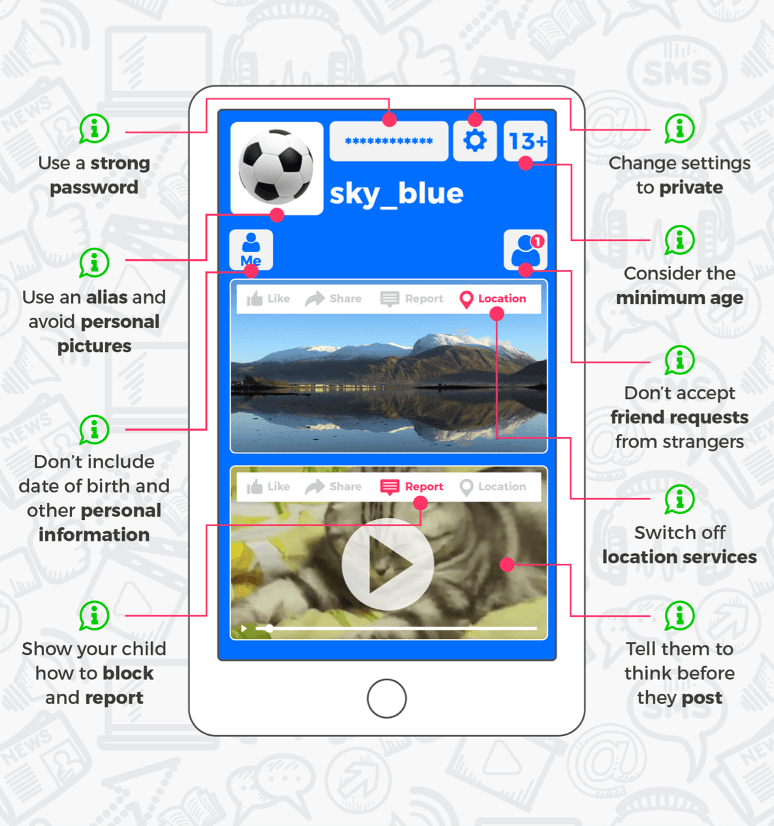Dark Spaces of the Internet: Cyberbullying During Lockdown
ADvTECH Group • June 8, 2020

How to Handle Cyberbullying During Lockdown
“Cyber bullies can hide behind a mask of anonymity online, and do not need direct physical access to their victims to do unimaginable harm.”
– Anna Marcia Chavez
With lockdown still a reality, students have been turning to the Internet to stay connected. As useful as the Internet is, not all children are aware of the dangers that the digital world imposes. What happens when innocent gestures like sharing one’s contact details leads to a traumatic case of cyberbullying? How can you help your child maintain an online social distance from cyber bullies? We’re here to guide you through it.
What Is Cyberbullying?
Cyberbullying is bullying that takes place online. Even though it can’t be physical violence, it can be detrimental to one’s mental health. Cyberbullying can easily occur on digital platforms through social media apps, texts and online gaming platforms.
Cyberbullying includes:
• Sending cruel, harsh or humiliating messages to someone.
• Forwarding embarrassing videos or photos to people.
• Sending unwanted sexual messages or images to people.
• Making abusive comments about someone. This includes homophobic, racist, transphobic or sexist remarks.
How Can I Help My Child If They're Experiencing Cyberbullying?
Cyberbullying can be difficult to control, but with the right steps it can be tackled. If you become aware that your child is being cyberbullied, follow these four steps to help them deal with the problem.
1. Talk To Them And Listen To What They Have To Say
It’s important to remember not to patronise your child. Instead, make them feel as if the power is in their hands and that you’re there to support them every step of the way.
2.Collect Evidence And Access The Situation
Once your child shares their cyberbullying experience, it’s time to assess the situation and collect evidence. Keeping a record of all interactions with the perpetrator is vital. Be vigilant from the beginning. Ask your child to screenshot anything offensive. This will be your evidence when reporting cyberbullying cases to site administrators, teachers, principals and to the police.
3. Report And Block
Enough is enough. Immediately block the perpetrator and then report them to site administrators. Site administrators are there to help support and protect people from online abuse.
If the cyberbully goes to the same school as your child, then be sure to report the case to your child’s teacher and principle.
4. Make Sure They Feel Safe
Be sure to protect your child’s online presence. Ensuring that your child’s social media platforms have a high privacy setting is a priority. This will help keep your child in control of who they’re talking to and who has access to view their social profiles.
It’s important to keep in mind that whilst the internet imposes a dark side, there are ways to avoid it. Here are some pro tips on how you can help protect your child on social media. Follow this social media profile example to ensure that your child’s online presence is protected.

Remember:
“Being challenged in life is inevitable, but being defeated is optional”
–
Roger Crawford.

By Laura Barrett, Intern Counselling Psychologist at Trinityhouse Glenvista Each year on 10 October , the world pauses to recognise World Mental Health Day, a reminder that mental well-being is not just an individual concern, but a shared responsibility among families, schools, and communities. As an Educational Psychologist working closely with children and families, I have seen first-hand how early conversations about mental health can change the course of a young person’s life. When emotional well-being is acknowledged and nurtured from a young age, children are better equipped to handle life’s challenges with confidence and resilience. Why conversations about mental health matter? Mental health is not a “grown-up” topic, it’s a human one. If children are not taught about emotions and coping mechanisms early on, they may grow into adults who struggle to manage stress, relationships, or change. Talking openly about feelings, naming emotions, and learning healthy coping strategies are all part of developing emotional literacy. These are the tools that help children and adults stay grounded through the ups and downs of life. At Trinityhouse, together with the world earlier this year, we explored the WRAP framework: Wellness, Resilience, Action and Purpose, a simple yet powerful approach to supporting children’s mental well-being. Each pillar plays a role in creating emotional stability and balance, not only for children but also for the families guiding them. Wellness begins with the basics. Adequate sleep, good nutrition, hydration, and rest may sound simple, but they lay the foundation for emotional regulation. A well-rested, nourished child is far more likely to cope effectively with daily stressors. Being mindful of mental health also involves small, practical steps like taking a few deep breaths before a stressful test or stretching during homework breaks. For adults, this might mean pausing for a cup of tea, taking a short walk, or simply naming what you’re feeling in the moment. Labelling emotions (“I feel anxious about this meeting”) helps calm the mind and re-engage rational thinking. Resilience isn’t about “always being strong.” It’s about learning to recover and grow after setbacks. Parents and teachers can nurture resilience by giving children space to express their struggles without judgement, then helping them explore possible solutions. When a child faces disappointment, a poor test result or a conflict with a friend, remind them of times they’ve overcome challenges before. Ask: “What helped you last time?” This reflective process empowers children to see themselves as capable problem-solvers, rather than passive victims of circumstance. Positive mental health requires active engagement, not just awareness. For families, this can mean creating calm, structured environments where children feel safe and heard. The Positive Parenting framework offers five helpful practices to support this: Empathy : Validate your child’s emotions instead of dismissing them. “I can see you’re upset about your toy” goes further than “Don’t cry, it’s not a big deal.” Positive Reinforcement : Celebrate effort and progress, no matter how small. A star chart or extra family time can be simple yet powerful motivators. Consistent Boundaries : Predictable routines and clear consequences make children feel secure. Boundaries should be calm, firm, and fair. Open Communication : Create family moments for honest sharing. Ask, “What was the best part of your day?” and really listen to the answer. Co-regulation : Young children often mirror their parents’ emotions. When you model calmness through deep breathing or gentle reassurance you teach them to regulate their own feelings. A sense of purpose is vital for both adults and children. It gives meaning to our actions and connects us to something larger than ourselves. Encourage children to explore hobbies and interests that bring them joy and fulfilment, whether it’s art, sport, volunteering, or spending time outdoors. These pursuits help build identity, confidence, and belonging. For parents, purpose can come from nurturing both their children’s and their own mental health. The saying “You cannot pour from an empty cup” is particularly true here. When parents take care of themselves, physically, mentally, and emotionally, they model balance and self-respect for their children. Recognising when a child is struggling Even with the best support, children can experience emotional challenges. Warning signs may include withdrawal from friends, sudden changes in sleep or appetite, irritability, or declining motivation. These can indicate stress, anxiety, or burnout. If you notice these signs, open a gentle conversation: “I’ve noticed you haven’t seemed yourself lately. Would you like to talk about it?” Sometimes, simply being heard is the first step toward healing. Continuing the conversation The most inspiring shift in recent years is how openly young people now speak about mental health. Many no longer see anxiety, sadness, or stress as weaknesses but as part of the human experience. This honesty offers hope for a more empathetic, emotionally literate generation. On this World Mental Health Day , let’s extend that conversation beyond schools and into our homes. Let’s practise a WRAP culture together by building Wellness, Resilience, Action and Purpose not only in our children’s lives but in our own. At Trinityhouse , we believe education extends beyond academics, it’s about nurturing the heart and mind. By fostering open dialogue, emotional awareness, and resilience, we aim to create an environment where every child feels seen, supported, and empowered to thrive. When families make mental health a daily priority, we don’t just raise stronger children, we raise a kinder, calmer and more connected generation.

One of the most significant academic decisions your child will make in their school career is which subjects to select. For many South African families, it can feel like a daunting task filled with pressure, uncertainty, and long-term consequences. But with the right support, tools, and guidance, parents can help their children make well-informed decisions that set them up for future success, both academically and professionally. The foundation of good subject choices lies in understanding your child’s academic ability and current performance. Subjects like Mathematics, Physical Sciences, and Accounting require solid results in Grade 9 and a strong grasp of key concepts. Similarly, subjects like Engineering Graphics & Design (EGD) or Visual Arts cater to students with practical and creative aptitudes. Consider your child’s learning style: do they prefer theory, or do they thrive with hands-on learning? Although, it is normal to want what’s best for your child’s future, you should not force them to live up to your ideal of success. Rather initiate conversations about possible careers or areas of interest and explore how different subjects align with those pathways. Platforms like YENZA Careers are incredibly helpful in this regard. YENZA uses psychometric assessments to offer realistic subject recommendations based on your child’s strengths, interests, and potential career matches, and it gives parents access to the results too. “Choosing the right subjects is a balance of academic ability, interest, and long-term thinking,” says Sumari Purdon , Head of Academics for Trinityhouse Schools. “We encourage families to use this opportunity to start meaningful conversations about the future, with support from tools like YENZA and input from educators who know the student well.”












